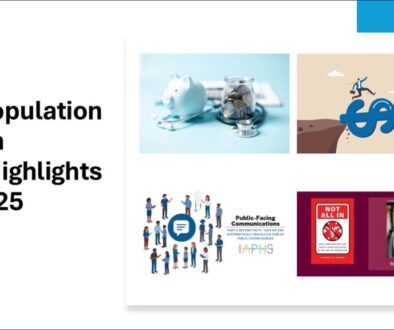Estimating an Invisible Population: Children Exposed to Family Overdose Deaths
Cayley Ryan-Claytor, Nilakshi Sarkar, Michelle Sarah Livings
Since the 1970s, deaths due to drug and alcohol overdoses have risen exponentially in the U.S., with more than 100,000 deaths in 2023 alone. Alcohol-induced deaths have accelerated over the past decade. Young adults born in the 1990s are at especially high likelihood of substance use as they age. The root causes of overdose deaths are multi-faceted and interdependent, with scholars identifying physical and mental health conditions, limited employment and educational opportunities, and mass incarceration as some of the key determinants of overdose risk. Changes in the drug supply have added another layer of complexity: the main drugs involved in overdoses shifted from prescription opioids in the late 2000s and heroin into the early 2010s to synthetic opioids and fentanyl in the 2010s, with increasing polysubstance use in the 2020s.
Every individual drug overdose death leaves behind a network of bereaved family, friends, and community members who must contend with the loss of a loved one. Using a nationally representative survey design, Alison Athey and colleagues found that 125 million American adults (42% of the population) personally knew at least one person who had died from overdose. About 40 million adults — or 1 in 3 adults who experienced an overdose loss — reported that the bereavement caused a disruption to their lives for at least a short time, with more than 12 million adults reporting a significant ongoing disruption.
What about the kids?
Children are also victims of the overdose epidemic. Mortality surveillance indicates that 4,404 children under age 18 died from drug or alcohol-induced causes between 2018 and 2023, including 1,128 children under 10 — staggering numbers in their own right.
But, the overdose crisis is wreaking a far larger, but far less visible toll on children than these numbers imply. The experience of a family member’s death during childhood is linked to developmental and behavioral challenges and poorer physical and mental health throughout the life course. Experiencing a parent’s death during childhood increases a child’s future risks of depression and suicide. Children with a deceased parent can also experience negative educational outcomes — they are more likely to be expelled from school, less likely to be in gifted classes, and more likely to develop a disability. Further, children who lose loved ones to overdose in particular are at uniquely high risk of future alcohol and substance abuse — a dynamic that compounds the effects of the overdose epidemic in future generations.
A number of high-quality surveys focused on drug use behaviors and health outcomes are available as valuable resources for researchers and policymakers. However, with a few exceptions (shoutouts to NSDUH, NatSCEV, and YRBSS!), these surveys are rarely administered to children despite the evidence that they are a population uniquely vulnerable to the loss of family members. This is largely due to ethical and logistical concerns about asking minors about highly sensitive and often stigmatized experiences, such as exposure to illicit substance use or drug overdoses.
So how can we take the first step of counting how many children have experienced family overdose deaths?
Estimating childhood exposure to family overdose losses
When surveys are unavailable or inappropriate, we can turn to formal demographic methods to help estimate the size of “invisible” populations. In a recent study, we take advantage of advances in kinship modeling to estimate the number of U.S. children who have experienced the loss of at least one family member to drug overdose. We use readily available data on birth rates and cause-specific death rates from CDC WONDER to estimate U.S. children’s age-by-year exposure to overdose losses among a wide range of biological family members (fathers, mothers, brothers, sisters, grandfathers, grandmothers, uncles, aunts, and male and female cousins).
The findings are deeply alarming: More than 1.4 million children in the United States experienced the death of a family member from overdose between 2000 and 2019. The majority of these bereaved youth were adolescents.
But this number also includes upwards of 400,000 children under the age of 10 in 2019. These younger cohorts experienced higher rates of loss at each age than did older cohorts (children aged 10-17 in 2019), which signals an entrance to adolescence at even greater disadvantage than their predecessors. Most losses occurred among parents, grandparents, and aunts/uncles.
Importantly, these estimates are likely conservative when it comes to the number of children affected by overdose deaths among loved ones, given that we restricted our analysis by considering the deaths of only biological family members. Many more children have undoubtedly been affected by overdose deaths of friends or community members like teachers, coaches, and neighbors.
What comes next?
Researchers, policymakers, and community activists continue to work tirelessly to reduce substance use behaviors and mitigate their effects on individuals and families. These efforts have led to new guidelines around the prescription of opioids, harm-reduction interventions, and increased taxes on alcoholic beverages in some states. However, researchers argue that systemic change is needed, calling for decriminalization of drug use, accessible health care, and greater social and economic investment in poor and working-class communities.
The unique needs of children bereaved by overdose losses could be addressed by additional interventions, such as
- Greater investment in adolescent substance use prevention programs shown to be effective through independent empirical research
- Increased hiring and trauma-informed training of school counselors and psychologists in public schools, particularly in rural and lower-income areas, and school-based campaigns to reduce the stigma around overdose deaths
- Continued investment in social safety net programs aimed at children and adolescents, including WIC, Head Start and Early Head Start, CHIP, and free school meal programs
- Proactive identification and enrollment in Social Security survivors’ benefits of children who lose eligible parents or guardians. Estimates suggest only half of bereaved children eligible for these life-altering benefits actually receive them. New efforts by the SSA to increase these numbers, and greater awareness of these programs, are critical.
Further research into the needs and challenges faced by the 1.4 million children (and counting) exposed to familial overdose deaths is key to mitigating how the overdose epidemic affects current and future generations.








All comments will be reviewed and posted if substantive and of general interest to IAPHS readers.